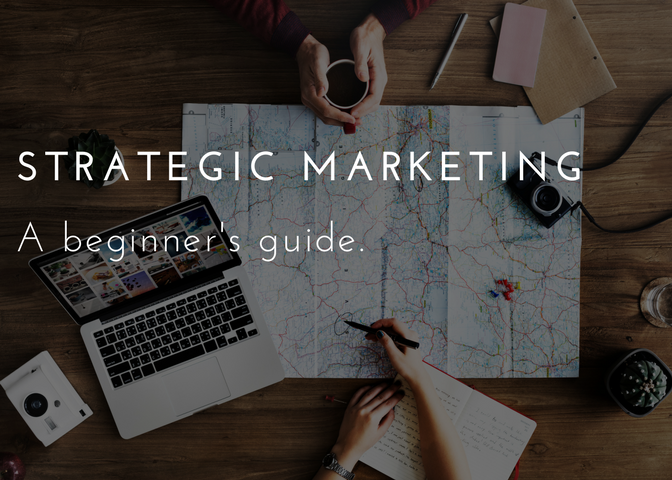Strategic Marketing: A Beginner’s Guide
 Marketers often find a challenging to prove the value of their efforts. But, if all of your initiatives fit into a strategy that is designed to support the goals of your organization, and to measure the results and impact, this won’t be a problem for you. Especially if you are using powerful marketing tools. Because when you have marketing goals defined, along with the strategies that support them and measurements for, success you have a clear path to building initiatives in designed to support your organization’s goals, whatever they might be.
Marketers often find a challenging to prove the value of their efforts. But, if all of your initiatives fit into a strategy that is designed to support the goals of your organization, and to measure the results and impact, this won’t be a problem for you. Especially if you are using powerful marketing tools. Because when you have marketing goals defined, along with the strategies that support them and measurements for, success you have a clear path to building initiatives in designed to support your organization’s goals, whatever they might be.
Your marketing strategy includes all the different components that you use to obtain your market’s attention. These components include actions such as research, advertising, and promotion. But Central to your marketing strategy are four core elements.
- What to promote? What is your product or service how do you depict your brand who promoted to.
- Who is your target market? Promoting through social media, television, radio, newspaper.
- How to promote it? How can your message have the most impact?
Your marketing strategy affects the way you run your entire business, so it should be planned in developed in consultation with your team. It is a wide-reaching and comprehensive strategic planning tool that describes your business and its products, explains the position and role of your products in the market, profiles your customers and your competition, identifies the marketing tactics you will use, and allows you to build a marketing plan and measure its effectiveness.
A marketing strategy sets the overall vision and direction for your marketing. This is different from a marketing plan. A marketing plan outlines the specific actions you will take to implement your marketing strategy. While your marketing strategy could be developed to cover the next few years, your marketing plan usually describes tactics for the current year.
Effective marketing starts with a considered, well-informed marketing strategy, that helps you in several important ways. It helps you to find your vision mission and business goals, and outlines how you will achieve them. It helps you build a strong reputation for your products it helps you target your products and services to the people most likely to buy them, and it usually involves creating powerful ideas to raise awareness and sell your products.
To develop your marketing strategy, identify your overarching business goals so that you can define a set of marketing goals to support them. Your business goals might include increasing awareness, selling more products, or reaching a new customer segment.
When setting goals, make sure you define them so that you’ll be able to measure the business metrics that you use to define success. A simple criteria for goal setting is the S.M.A.R.T method in which goals are:
- Specific
- Measurable
- Achievable
- Relevant
- Time-bound
A few things to consider in order to ensure success and developing your marketing goals and strategy:
Think strategically
Include stakeholders from across your organization and your strategic discussions as your marketing strategy will impact everyone in the organization.
Research your market
Research is an essential element in developing a marketing strategy. You’ll want to gather information about your market such as its size growth social trends and demographics. Continue to keep an eye on your market so you’re aware of any changes that might require updates to your strategy.
Profile your potential customers
Use your market research to create buyer personas as personas are fictional representations of your ideal customers that are developed based on customer demographics and behavior along with your own understanding of their motivations and challenges.
Profile your competitors
As part of your marketing strategy you should develop a profile of your competitors by identifying their products supply chain pricing and marketing tactics. Use this to identify your competitive advantage.
Define your goals
With personas created and buyer journeys mapped, you can define the marketing goals that contribute to the success of your organization.
Develop your key performance indicators
Once you have marketing goals defined, you can set your key performance indicators or KPIs for success
Develop your marketing strategies
With your goals and measurements defined now you can design a set of strategies to achieve them. An example goal could be to increase young people’s awareness of your products. The corresponding strategy could be to increase your online social media presence, by posting regular updates about your product on Twitter or Facebook.
Create a cross-channel strategy
When creating your marketing strategy consider all of your channels and how they will work together to support your marketing initiatives.
Test your ideas
In deciding your tactics, do some online research to test ideas and approaches, and review what works. You’ll probably need to use various tactics to reach the customers within your target market, meet their needs and improve your sales results.
In order to determine if your marketing strategy is working you need to measure key performance indicators or KPI’s. A KPI is a measure of an activity that provides insight into your return on investment in that activity. This includes the program’s messaging and content you create and share.
There are three main types of KPIs:
Tactical KPIs
These are used by marketers to understand how well their initiatives are performing in a specific channel such as email mobile social or the web measure usually centers around by her behaviors such as opens clicks page visits content downloads and form submissions.
Strategic KPIs
These are typically focused on results rather than by our behaviors. They help determine overall marketing performance versus specific behaviors like opens and clicks. Strategic KPIs can provide insight into how many new opportunities were created as the result of combined email programs, over a specific time frame. They can also identify how much additional pipeline was driven by marketing, how much pipeline became opportunities that closed, and how much revenue was generated due to marketing.
Operational KPIs
These are typically indicators of alignment between your cross-functional teams, and can help pinpoint areas for improvement in the sales and marketing funnel. For example, you might have KPIs that track the number of leads passed to sales. How many of those became sells qualified and how many were rejected? By examining the reasons for rejections, you can identify ways to improve the quality of leads passed to sales now that you have a grounding in the reasons.
